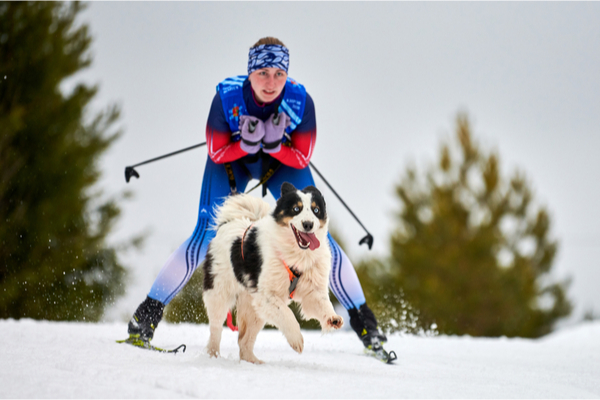If you and your best friend want an fun and lively to spend a Winter Day, perhaps you should try dog skiing, historically known as skijoring. t’s an exciting way to break out of the winter rut and spend exhilarating quality time with your active pet pal.
According to Daily Paws, Skijoring, from the Norwegian ski-kjøring or ‘ski-driving,’ was—and still is—a primary form of individual transport across massive snow-covered land in Finland, Norway, Russia, and Sweden. For centuries, the indigenous Sámi people in those northern regions traveled on skis pulled by reindeer. Over time, horses and dogs proved useful as well, especially in Northern China, Switzerland, and France.
These days, Skijoring is a primarily a competitive winter sport growing in popularity in which a person on skis is pulled by a horse, a dog or even a motor vehicle. It is derived from the Norwegian word skikjøring, meaning “ski driving”.
It’s really up to you how to approach this winter activity with your cold-weather pup. If enjoying the great outdoors when there’s just the right nip in the air is your thing, cross-country skiing on a trail with your furry best friend might be the perfect activity for the two of you to try.
But if you and your racy canine feel the need for speed, competition could be the goal. Jonathan Thompson is the co-founder of K0 Powered Sports, based in Minnesota. With his 6-year-old cattle dog, Baella, he’s both active in the sport and acts as a trainer for others. He says that anyone looking to get outdoors in the winter and provide their dog with unique enrichment can skijor—with one caveat.
“We should stress that the skijorer should already have a foundation in cross-country skiing,” he says. “We’re starting to see a lot of folks who are fascinated by the sport and want to get going but have no foundation in cross-country skiing. That’s always step one.” You can often find beginners’ classes through a local parks and recreation department, or with a surf and ski shop or an active outdoor retailer, such as REI. The more confident you are as a skier, the safer you and your dog will be.
Daily Paws says that many dog breeds can be trained to, and enjoy skijoring, not just the mushing Arctic wonders we’d first consider, such as Alaskan malamutes, Samoyeds, and Siberian huskies, but many other breeds, too, in various sizes. Want to feel the swift sprint of a greyhound? You can! Believe your border collie needs another to-do list item to keep his mind sharp? Skijoring might be the answer!
“We’ve seen dogs of all breeds and abilities succeed at this sport. We even have videos of dachshunds competing!” Thompson says. “However, depending on the experience one is looking for and the dog they have, certain breeds may lend themselves well for higher speed experience.”
He adds that these are some best skijoring dogs:
- Traditional northern breeds, like those mentioned above
- Hunting dog breeds
- Dock diving dogs, such as Whippets or Belgian Malinois
- Disc dogs, such as any type of Retriever
- Weight-pulling dogs, like a Great Pyrenees or Bernese Mountain dog
- High-energy pets of any Mixed Breed
- Even small- or medium-sized dogs who love to run, although they’ll be less likely to pull you and be more the scampering alongside or behind type
Hitting the trail with your snow-lovin’ dog will probably be similar to any other outing, but Thompson strongly advises that only canines who are well-socialized around other dogs and humans participate in competition settings. Either way, he recommends establishing a good foundation of basic skills and cues with your pooch—such as sit, stay, and so on—before leveling up to more advanced dog skiing training. Positive reinforcement skill training assures another measure of safety before the two of you venture out into the wilderness or into competition.
Before you head out to the snowy tundra with your dog, Daily Paws says it’s vital that you, you know, teach your dog to ski first. “First, consult with your veterinarian as to when your dog is ready to begin pulling sports,” Thompson says. “Generally, they don’t recommend it earlier than 1 year old, as the puppy is still developing.”
Once you get the green light, you can strap on all the gear and work on training with specific skijoring cues in a wide-open area, even when there’s no snow. Start slowly to help you both get a feel for the action. Your vocal intonation should be upbeat and convey excitement.
- Line-out: Move toward the trailhead and stop when the tugline is taught
- Hike or Let’s Go: Go!
- Get up: Speed up
- Whoa: Stop
- On-by: Ignore distractions, such as wildlife or movement of other dogs
- Gee: Turn right
- Haw: Turn left
- Easy: Slow down
Some cues might also be combined, such as ‘gee over’ or ‘haw back.’
You’ll also need to assess if your dog naturally wants to pull. “Sometimes following or chasing another skijoring team can be helpful for dogs that don’t instinctively understand to pull right away,” Thompson says.
Fitness training might include keeping your dog at optimum weight and building pulling strength before speed. Your veterinarian could have more ideas, such as modifying diet and hydration based on activity level.
Most importantly, always ensure your dog is having fun. If he/she is not, Thompson says, stop. Perhaps your dog is more of an apres ski pal, which is okay too.
—
Photo Credit: travelarium.ph / Shutterstock.com
